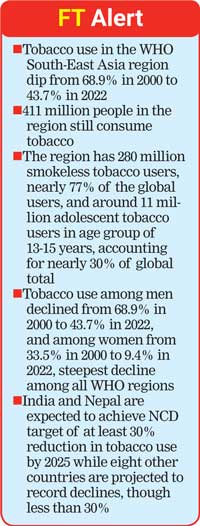Wednesday Apr 16, 2025
Wednesday Apr 16, 2025
Thursday, 22 February 2024 00:14 - - {{hitsCtrl.values.hits}}
 The World Health Organisation is calling on countries in South-East Asia region to intensify efforts to control tobacco and e-cigarette use, as despite steep decline over the years, tobacco consumption in the region continues to be the highest globally, and vaping is on the rise.
The World Health Organisation is calling on countries in South-East Asia region to intensify efforts to control tobacco and e-cigarette use, as despite steep decline over the years, tobacco consumption in the region continues to be the highest globally, and vaping is on the rise.
“The region still has the highest number of people using tobacco which puts them at risk of life-threatening diseases such as cancer, respiratory and heart disease. Urgent measures are also needed to control e-cigarettes, which have not been proven to be effective for smoking cessation. We must do all we can to control tobacco and e-cigarette use to protect health and save lives,” said WHO South-East Asia Regional Director Saima Wazed.
While tobacco use in the WHO South-East Asia region decreased from 68.9% in 2000 to around 43.7% in 2022, an estimated 411 million people in the region still consume tobacco, as per the latest trends released this year.
The region has 280 million smokeless tobacco users, nearly 77% of the global smokeless tobacco users, and around 11 million adolescent tobacco users in the age group of 13-15 years, accounting for nearly 30% of the global total.
The use of e-cigarettes, particularly among young people, is increasing in many countries, with co-use of e-cigarettes and conventional cigarettes being common. Thailand, which has been tracking e-cigarette use, reported a steep rise in e-cigarette use among school-aged children of 13 to 15 years, from 3.3% in 2015 to 17.6% in 2022.
WHO is committed to support policies aimed at countering tobacco and e-cigarette industries’ interference for safeguarding health of the over 2 billion people in the region, the Regional Director said.
While DPR Korea, India, Nepal, Sri Lanka, Thailand, and Timor-Leste have banned e-cigarettes, Maldives regulates e-cigarettes as tobacco products.
Over the years, countries in the region have made significant progress in combating tobacco. Tobacco use among men declined from 68.9% in 2000 to 43.7% in 2022, and among women from 33.5% in 2000 to 9.4% in 2022, the steepest decline among all WHO regions.
The region, alongside the WHO African region, is on track to achieve the NCD 2025 target of a 30% reduction in tobacco use by 2025.
India and Nepal are expected to achieve the NCD target of at least 30% reduction in tobacco use by 2025 while eight other countries are projected to record declines, though less than 30%.
While Bangladesh has announced “Tobacco Free Bangladesh” by 2040, India has initiated ‘Tobacco Endgame’.
Countries in the region are implementing demand reduction strategies as advocated by WHO MPOWER package and other initiatives for tobacco control. Given the high interference of tobacco industry, more assertive actions are needed to enforce tobacco control laws and policies.